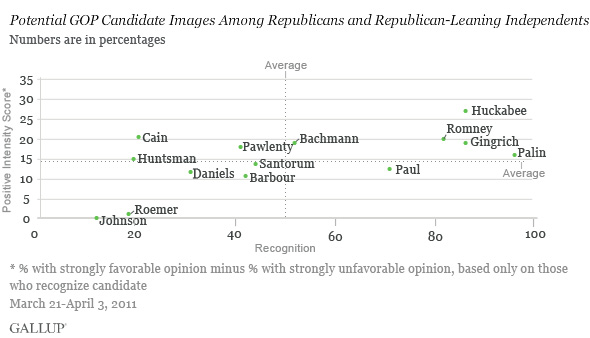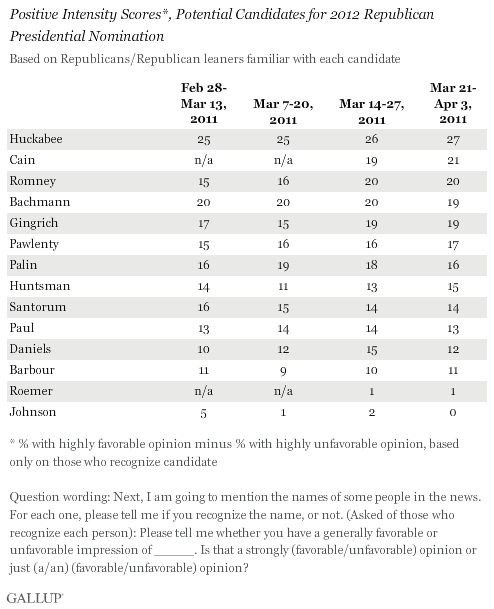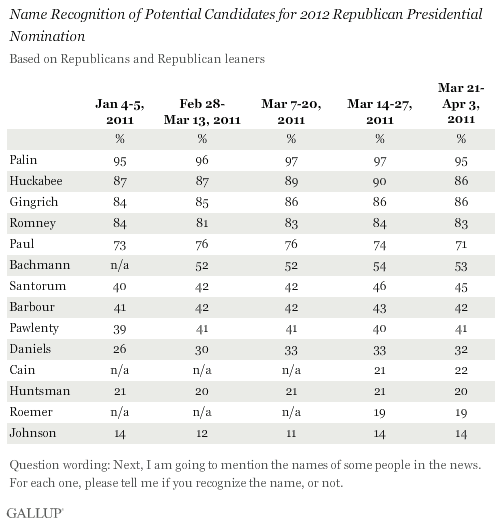PRINCETON, NJ -- With President Obama officially announcing his candidacy for re-election on Monday, the question of whom he will run against becomes even more relevant. Three possible Republican candidates -- Mike Huckabee, Mitt Romney, and Newt Gingrich -- are currently best situated among Republicans nationwide in terms of name recognition and Gallup Positive Intensity Scores. Sarah Palin and Ron Paul are also well known, but generate lower net enthusiasm from those who know them. Of the less well-known potential GOP candidates, Herman Cain, Michele Bachmann, and Tim Pawlenty have the highest Positive Intensity Scores.

The accompanying graph provides a visual representation of the recognition and Positive Intensity Scores for each of 14 potential GOP candidates included in Gallup tracking conducted March 21-April 3.
The three potential candidates -- Huckabee, Romney, and Gingrich -- located in the upper right-hand area of the graph have both high name recognition and strongly positive images relative to other candidates. Palin has almost universal name recognition, but her Positive Intensity Score is now 16, below that of the leaders -- particularly Huckabee, whose score is up to 27. Seventy-one percent of Republicans know Texas Rep. Paul, but he has a lower Positive Intensity Score of 13.
Several less well-known Republicans stand out because their Positive Intensity Scores among Republicans who recognize them are relatively high, comparable to Romney's and Gingrich's scores. These include former Godfather's Pizza CEO Cain, with a Positive Intensity Score of 21, Minnesota Rep. Bachmann, at 19, and former Minnesota Gov. Pawlenty, at 17.

The name recognition scores essentially divide the field into three groups. The first group -- composed of Palin, Huckabee, Gingrich, Romney, and Paul -- has a history of significant national exposure and enjoys high 70+% name ID among Republicans. The second group -- Bachmann, Rick Santorum, Haley Barbour, and Pawlenty -- is moderately well known, with recognition scores between 41% and 53%. The rest of those included in Gallup's tracking are not well known, with recognition scores stretching from 32% for Indiana Gov. Mitch Daniels to the overall low of 14% for former New Mexico Gov. Gary Johnson.
The overall recognition of the various potential Republican candidates among Republicans is similar to what it has been in recent weeks, despite active travel schedules for several of these politicians.

Implications
News accounts suggest that Obama is on track to raise and spend $1 billion in his 2012 re-election bid, significantly more than the $700+ million his campaign spent in 2008. Obama has several advantages over any potential challenger heading into the 2012 election: he is an incumbent president able to dominate news coverage with his official actions; he has already assembled a campaign team at work on his re-election campaign; he is on track to raise record amounts of money; and he likely will be unopposed for his party's nomination. These realities may be causing potential Republican candidates to think carefully before making their candidacies official.
Gallup's ongoing tracking shows that former Arkansas Gov. and current Fox News commentator Huckabee is the GOP leader at this point, based on his high name recognition and advantage in Positive Intensity. Huckabee also leads when Gallup asks Republicans whom they would support for the nomination. It remains unclear, however, whether Huckabee will end up running for his party's nomination.
Gingrich and Romney are clearly in second place behind Huckabee, based on their name identification and Positive Intensity Scores. However, neither man generates levels of support from Republicans that are as high as Huckabee's, and neither has been able to change his status much over the last month. Gingrich has been more public about his intention to run for president, while Romney has maintained a somewhat lower national profile, even while traveling extensively to early primary and caucus states.
As is the case for Huckabee, Palin's intentions about running for president next year are unknown. By virtue of her inclusion on the national GOP ticket in 2008 and her ongoing television exposure, she is almost universally known among Republicans nationwide. But Palin's positioning in the minds of Republicans who do know her is weaker than that of other potential candidates: 23% of those who recognize her have a strongly favorable opinion, compared with 7% who are strongly unfavorable.
The potential for other less well-known Republicans to increase their name recognition and become serious contenders for their party's nomination is the interesting question going forward. The data clearly show that Bachmann and Cain have a reaction-generating edge among those who know them, which in theory puts them in a position to make an impact if they can become better known. Pawlenty, who appears to be making a serious run at the presidency, is known by about 4 out of 10 Republicans and has a Positive Intensity Score slightly below Cain's and Bachmann's. Other, less well-known candidates such as Mississippi Gov. Barbour, Ambassador to China Jon Huntsman, and Daniels currently do not generate high positive emotions from those who know them, something that would need to change if they are to contend for the nomination.
Survey Methods
Results are based on telephone interviews conducted as part of Gallup Daily tracking March 21-April 3, 2011, with random samples of Republicans and Republican-leaning independents, aged 18 and older, living in all 50 U.S. states and the District of Columbia, selected using random-digit-dial sampling. Questions asking about the 14 potential candidates measured in this research were rotated among randomly selected samples of Republicans each night; over the 14-day period, each candidate was rated by a minimum of 1,500 Republicans and Republican-leaning independents.
For the overall ratings of each candidate among Republicans and Republican-leaning independents, including recognition scores, one can say with 95% confidence that the maximum margin of sampling error is ±3 percentage points. For the Positive Intensity Score for each candidate, the maximum margin of sampling error varies depending on the size of the group recognizing the candidate.
Interviews are conducted with respondents on landline telephones and cellular phones, with interviews conducted in Spanish for respondents who are primarily Spanish-speaking. Each daily sample includes a minimum quota of 200 cell phone respondents and 800 landline respondents, with additional minimum quotas among landline respondents for gender within region. Landline respondents are chosen at random within each household on the basis of which member had the most recent birthday.
Samples are weighted by gender, age, race, Hispanic ethnicity, education, region, adults in the household, cell phone-only status, cell phone-mostly status, and phone lines. Demographic weighting targets are based on the March 2010 Current Population Survey figures for the aged 18 and older non-institutionalized population living in U.S. telephone households. All reported margins of sampling error include the computed design effects for weighting and sample design.
In addition to sampling error, question wording and practical difficulties in conducting surveys can introduce error or bias into the findings of public opinion polls.
For more details on Gallup's polling methodology, visit www.gallup.com.
